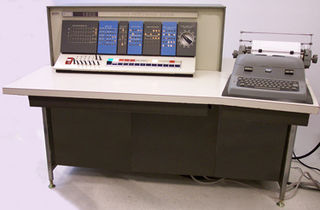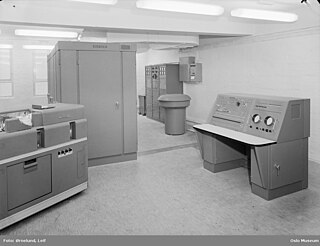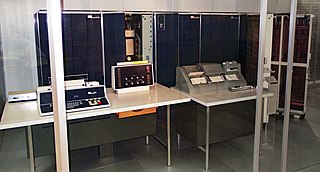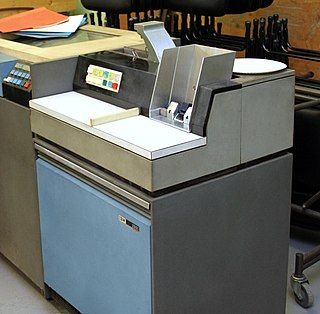
A punched card is a piece of card stock that stores digital data using punched holes. Punched cards were once common in data processing and the control of automated machines.

The IBM 1620 was announced by IBM on October 21, 1959, and marketed as an inexpensive scientific computer. After a total production of about two thousand machines, it was withdrawn on November 19, 1970. Modified versions of the 1620 were used as the CPU of the IBM 1710 and IBM 1720 Industrial Process Control Systems.

The IBM 650 Magnetic Drum Data-Processing Machine is an early digital computer produced by IBM in the mid-1950s. It was the first mass-produced computer in the world. Almost 2,000 systems were produced, the last in 1962, and it was the first computer to make a meaningful profit. The first one was installed in late 1954 and it was the most popular computer of the 1950s.

IBM 1442 is a combination IBM card reader and card punch. It reads and punches 80-column IBM-format punched cards and is used on the IBM 1440, the IBM 1130, the IBM 1800 and System/360 and is an option on the IBM System/3.

Starting at the end of the nineteenth century, well before the advent of electronic computers, data processing was performed using electromechanical machines collectively referred to as unit record equipment, electric accounting machines (EAM) or tabulating machines. Unit record machines came to be as ubiquitous in industry and government in the first two-thirds of the twentieth century as computers became in the last third. They allowed large volume, sophisticated data-processing tasks to be accomplished before electronic computers were invented and while they were still in their infancy. This data processing was accomplished by processing punched cards through various unit record machines in a carefully choreographed progression. This progression, or flow, from machine to machine was often planned and documented with detailed flowcharts that used standardized symbols for documents and the various machine functions. All but the earliest machines had high-speed mechanical feeders to process cards at rates from around 100 to 2,000 per minute, sensing punched holes with mechanical, electrical, or, later, optical sensors. The operation of many machines was directed by the use of a removable plugboard, control panel, or connection box. Initially all machines were manual or electromechanical. The first use of an electronic component was in 1937 when a photocell was used in a Social Security bill-feed machine. Electronic components were used on other machines beginning in the late 1940s.

The IBM 407 Accounting Machine, introduced in 1949, was one of a long line of IBM tabulating machines dating back to the days of Herman Hollerith. It had a card reader and printer; a summary punch could be attached. Processing was directed by a control panel.

The IBM 305 RAMAC was the first commercial computer that used a moving-head hard disk drive for secondary storage. The system was publicly announced on September 14, 1956, with test units already installed at the U.S. Navy and at private corporations. RAMAC stood for "Random Access Method of Accounting and Control", as its design was motivated by the need for real-time accounting in business.

The DEUCE was one of the earliest British commercially available computers, built by English Electric from 1955. It was the production version of the Pilot ACE, itself a cut-down version of Alan Turing's ACE.

The tabulating machine was an electromechanical machine designed to assist in summarizing information stored on punched cards. Invented by Herman Hollerith, the machine was developed to help process data for the 1890 U.S. Census. Later models were widely used for business applications such as accounting and inventory control. It spawned a class of machines, known as unit record equipment, and the data processing industry.

A plugboard or control panel is an array of jacks or sockets into which patch cords can be inserted to complete an electrical circuit. Control panels are sometimes used to direct the operation of unit record equipment, cipher machines, and early computers. The array of holes is often contained in a flat removable panel that can be inserted into a machine and pressed against an array of contacts. This allows the machine to be quickly switched between different applications.

IBM 7070 is a decimal-architecture intermediate data-processing system that was introduced by IBM in 1958. It was part of the IBM 700/7000 series, and was based on discrete transistors rather than the vacuum tubes of the 1950s. It was the company's first transistorized stored-program computer.

From the invention of computer programming languages up to the mid-1970s, most computer programmers created, edited and stored their programs line by line on punch cards.

The IBM 2540 is a punched-card computer peripheral manufactured by IBM Corporation for use of System/360 and later computer systems. The 2540 was designed by IBM's Data Processing Division in Rochester, Minnesota, and was introduced in 1965. The 2540 can read punched-cards at 1000 cards per minute (CPM) and punch at 300 CPM. The 2540 is based on the design of the older, slightly slower, 1402.
The IBM 2780 and the IBM 3780 are devices developed by IBM for performing remote job entry (RJE) and other batch functions over telephone lines; they communicate with the mainframe via Binary Synchronous Communications and replaced older terminals using synchronous transmit-receive (STR). In addition, IBM has developed workstation programs for the 1130, 360/20, 2922, System/360 other than 360/20, System/370 and System/3.

The IBM 1402 was a high-speed card reader/punch introduced on October 5, 1959 as a peripheral input/output device for the IBM 1401 computer. It was later used with other computers of the IBM 1400 series and IBM 7000 series product lines. It was adapted as the IBM 1622 Card Read-Punch for the IBM 1620 and provided the basic design for the models 2501, 2520 and 2540 equipment used with the IBM System/360 product line.

A computer punched card reader or just computer card reader is a computer input device used to read computer programs in either source or executable form and data from punched cards. A computer card punch is a computer output device that punches holes in cards. Sometimes computer punch card readers were combined with computer card punches and, later, other devices to form multifunction machines.

The IBM 711 was a punched card reader used as a peripheral device for IBM mainframe vacuum tube computers and early transistorized computers. Announced on May 21, 1952, it was first shipped with the IBM 701. Later IBM computers that used it were the IBM 704, the IBM 709, and the transistorized IBM 7090 and 7094.

The IBM 2501 is a punched-card reader from IBM with models for the System/360 and System/370 mainframe systems and for the IBM System/360 Model 20, the IBM 1130 and IBM System/3 minicomputers. 2501 models can read 80-column cards at either 600 or 1000 cards per minute (CPM).

The IBM 3505 is a reader for 80-column punched cards. It can read cards punched in EBCDIC or column binary at up to 1200 cards per minute (CPM). The IBM 3525 is a multi-function punched card device, capable of reading, punching, and printing on punched cards. The 3505 contains an integrated control unit that attaches to a System/370 byte multiplexer, selector, or block multiplexer channel. An optional feature of the 3505 allows the control unit to also control a 3525, although the two are separately-addressed devices.

IBM designed, manufactured and sold optical mark and character readers from 1960 until 1984. The IBM 1287 is notable as being the first commercially sold scanner capable of reading handwritten numbers.



















